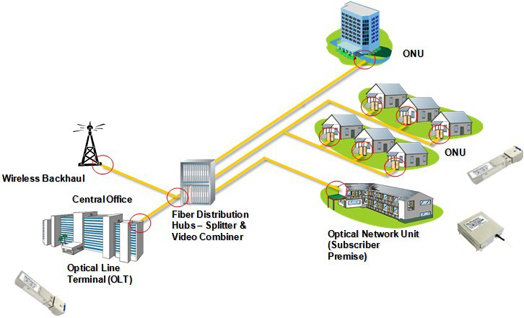
产品分类:应用指导


Overview
The growth of telecom network traffic is intensified by the proliferation of mobile and fixed network-attached devices, including smartphones, laptops and netbooks, e-readers, PCs, televisions and gaming devices, that are enabling consumers to access content at increasing data rates anytime and anywhere. The growing widespread use of IP-based video, including user-generated video, IPTV, streaming web video, video conferencing and mobile video enabled by 3G and LTE wireless infrastructures, has especially contributed to the growth in network traffic. F-toneNetworks products provide the critical infrastructure that connects these myriad devices to the optical network, including backhaul of mobile date and advanced Fiber-To-The-Home (FTTH) and business access.
Wireless Backhaul
Mobile data traffic has been growing very rapidly, and according to a press release by Ericsson (March 23, 2010) mobile data traffic surpassed mobile voice traffic in December of 2009. The proliferation of smart phones and video driven devices, like the Apple iPad, places great strains on the wireless data network, which is in truth only wireless for the last kilometer or so. Increasingly, operators are turning to optical interconnections to provide the bandwith and flexibility necessary to accommodate this traffic growth. Optical fiber systems are used for connecting remotely located antennas, aggregating traffic and backhauling traffic into the metro networks. F-toneNetworks makes a wide variety of transceivers and other optical modules which are used in these systems.
Fiber-To-The-Home
Major deployments of fiber-to-the-home (FTTH) networks are underway in North America, Japan, China and Europe. Most utilize passive optical network (PON) configurations, as shown above, which combine fibers from up to 32 (or sometimes 64, and for NG-PON 128/256) subscribers into a single fiber at the splitter cabinet, up to 20 km (or up to 60km using an extender device) distant from the access hub, which is often located at a central office. This network architecture simplifies fiber deployment and management, and is the architecture used in today’s networks. However, demands for much higher data rates and remotely-managed dynamic reconfigurability are expected to require major upgrades to the access portion of the network and moving access hubs to the edge of the network to be in the immediate neighborhood of customers.
There are three key optical modules required for these PON systems (see diagram above): 1) an optical network unit (ONU) transceiver at the subscriber premise (a Subscriber Unit): 2) an optical line terminal (OLT) transceiver at the access hub which handles traffic from multiple subscribers (a Line Unit): 3) a passive optical device, either a splitter or a multi-channel filter, which combines the multiple end-user fibers at a splitter cabinet into the one fiber which continues to the access hub. In addition, there are currently two different widely deployed international standards for such PON systems: GEPON and GPON. F-toneNetworks serves the FTTH market by manufacturing all of these types of PON modules for both of the main standards (GPON and GEPON). F-toneNetworks sells these products in North America, Japan and China.
Driven by the need for greater bandwidth and flexibility, PON systems are evolving to Next Generation PON (NG-PON), which drives the access speed up to 10Gbps from current 1G or 2.5G. There are several NG PON access systems: 10G/1G asymmetrical EPON, 10G/10G symmetrical EPON, 10G/2.5G XG-PON1 GPON, and 10G/10G XG-PON2 GPON. Also under development is WDM-PON, which provides a separate wavelength and virtually unlimited bandwidth to each subscriber. WDM-PON will initially be deployed for business access applications, but may eventually be used in for residential connections. F-toneNetworks is very active in development of these advanced systems, and is utilizing its PIC technology to achieve the performance and efficiency necessary for deployment.